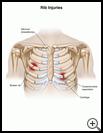
Costochondritis
________________________________________________________________________
KEY POINTS
- Costochondritis is swelling and irritation of the tissue that attaches a rib to your breastbone.
- Symptoms usually only last for a few weeks.
- Costochondritis can be treated with heat or ice and sometimes medicine.
- Avoid movements or activities that cause pain until the tissue heals.
________________________________________________________________________
What is costochondritis?
Costochondritis is swelling and irritation of the cartilage between the ribs. Cartilage is the tissue that lines and cushions the surfaces of joints.
The pain of costochondritis usually lasts for a week or two. It does not cause any long-term problems.
What is the cause?
The cause of costochondritis is not always known. It may be caused by:
- An injury to the chest, for example from falling or getting hit in the chest
- Severe coughing or vomiting
- Straining your chest from too much exercise
What are the symptoms?
The main symptom is pain or tenderness in the front of your chest near the breastbone. It is usually a sharp pain that gets worse if you:
- Press on it
- Move or stretch in certain ways
- Take a deep breath, cough, sneeze, or laugh
Chest pain can also be caused by a heart attack. Call 911 or your local emergency services right away if you have symptoms of a heart attack. The most common symptoms include:
- Chest pain or pressure, squeezing, or fullness in the center of your chest that lasts more than a few minutes, or goes away and comes back (may feel like indigestion or heartburn)
- Pain or discomfort in one or both arms or shoulders, or in your back, neck, jaw, or stomach
- Trouble breathing
- Breaking out in a cold sweat for no known reason
- If your provider has prescribed nitroglycerin for angina, pain that does not go away after taking your nitroglycerin as directed
Along with other heart attack symptoms, you may also feel very tired, faint, or sick to your stomach.
How is it diagnosed?
Your healthcare provider will ask about your symptoms and medical history and examine you. You may have tests or scans to check for other possible causes of your symptoms.
How is it treated?
Costochondritis is treated with nonprescription pain medicine such as acetaminophen, aspirin, ibuprofen, or naproxen. Read the label and take as directed. Unless recommended by your healthcare provider, you should not take these medicines for more than 10 days.
- Nonsteroidal anti-inflammatory medicines (NSAIDs), such as ibuprofen, naproxen, and aspirin, may cause stomach bleeding and other problems. These risks increase with age.
- Acetaminophen may cause liver damage or other problems. Unless recommended by your provider, don't take more than 3000 milligrams (mg) in 24 hours. To make sure you don’t take too much, check other medicines you take to see if they also contain acetaminophen. Ask your provider if you need to avoid drinking alcohol while taking this medicine.
How can I help take care of myself?
Follow the full course of treatment prescribed by your healthcare provider. In addition:
- Avoid activities or movements that make the pain worse.
- Put moist heat on the sore area for 10 to 15 minutes at a time. Moist heat includes heat patches or moist heating pads that you can buy at most drugstores, a warm wet washcloth, or a hot shower. Put a hot water bottle or electric heating pad on your back. Cover the hot water bottle with a towel or set the heating pad on low. To prevent burns to your skin, follow directions on the package. Never lie on any kind of heating pad and trap the heat between your body and the pad. Don’t use heat if you have swelling.
- Some people find ice works better than heat to relieve the pain. Put an ice pack, gel pack, or package of frozen vegetables wrapped in a cloth on the area every 3 to 4 hours for up to 20 minutes at a time.
- When the pain is gone, go back to your normal activities slowly.
- Ask your provider:
- How and when you will get your test results
- How long it will take to recover
- If there are activities you should avoid and when you can return to your normal activities
- How to take care of yourself at home
- What symptoms or problems you should watch for and what to do if you have them
- Make sure you know when you should come back for a checkup. Keep all appointments for provider visits or tests.
How can I help prevent costochondritis?
You can help prevent chest injury by wearing chest protection during activities such as snowmobiling or riding 4-wheelers or dirt bikes. Pace yourself to avoid straining your chest. For example, if you lift weights, don’t increase the amount you lift, or the number of reps, by more than 10 to 15% each week.

